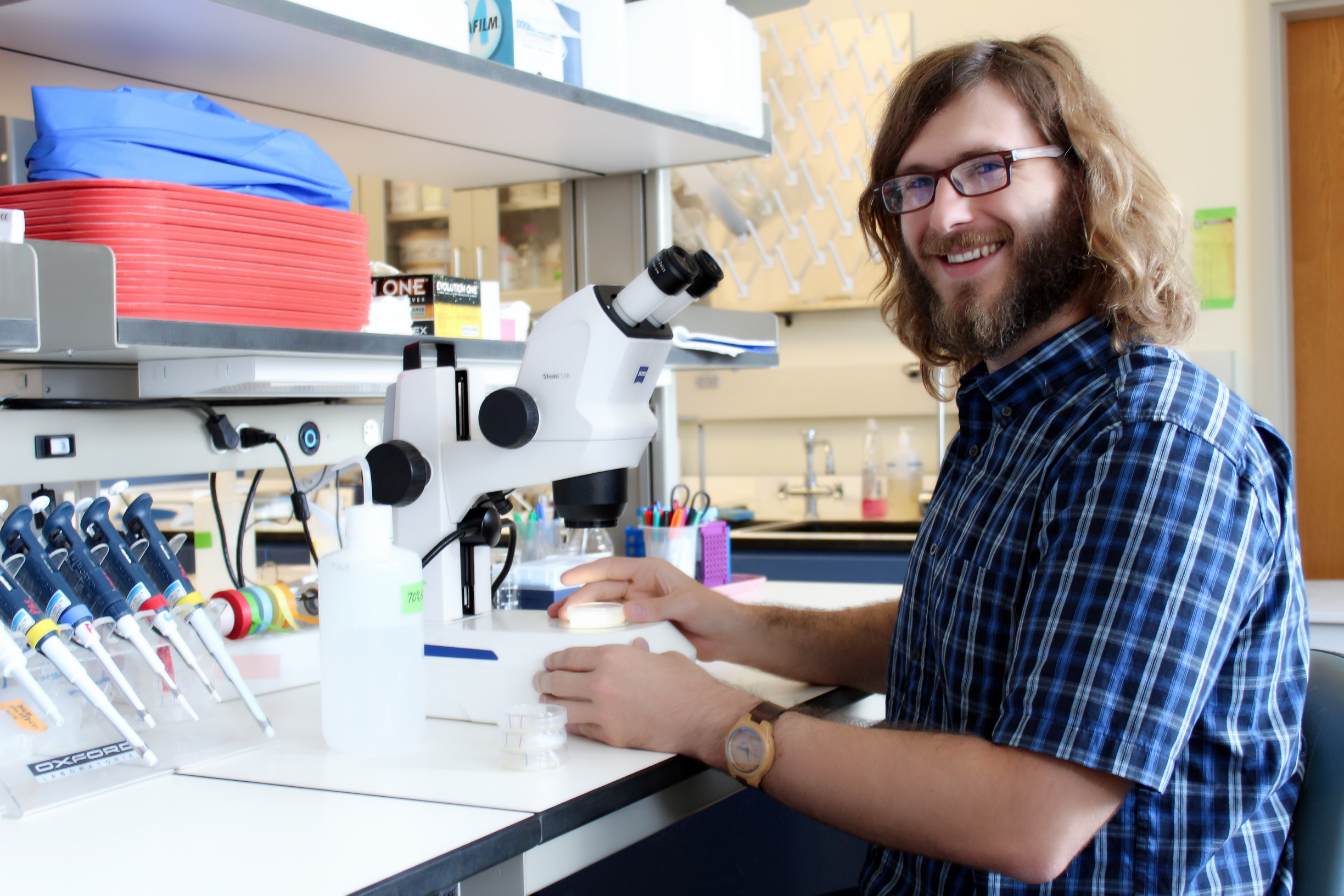
Joseph Dubie
Dr. Vaishali Katju Laboratory
Entrance year: 2016
Hometown: Winston, Oregon
“I use experimental evolution in C. elegans to explore how new mitochondrial mutations out compete existing variants within an individual and increase their chances of passing on to the next generation. In particular I am interested in how cellular environment, population structure, and level of heteroplasmy affect the final fate of a mutation. I am also interested in how nuclear genomes control and compensate for deleterious mitochondrial mutations.”
Research Specialties
Mitochondrial Genetics
Evolutionary Biology
Selfish Genetic Elements
What is at least one big lesson you have learned in the Genetics graduate program that you think is widely applicable to your future pursuits?
Fail forward. Don’t let failures stress you out. Just figure out what you did wrong, and try to do a little better next time.
When and how did you realize that you wanted to study Genetics?
I don’t know if I ever did. I just always took jobs that let me learn the things I wanted to learn. I have always loved animals and the outdoors so I got a job catching frogs and salamanders for stream surveys in the cold tributaries of the Cascade Mountain Range. I wanted to know more about how animals change and how these changes lead to speciation so I got another job doing molecular work for a systematist. I wanted to know more about how those molecular changes occur and so now I’m here.
Most Recent Research Publication:
“The conflict within: origin, proliferation and persistence of a spontaneously arising selfish mitochondrial genome”Joseph James Dubie, Avery Robert Caraway, McKenna Margaret Stout, Vaishali Katju and Ulfar Bergthorsson
Published:02 December 2019 https://doi.org/10.1098/rstb.2019.0174
Abstract:
Mitochondrial genomes can sustain mutations that are simultaneously detrimental to individual fitness and yet, can proliferate within individuals owing to a replicative advantage. We analysed the fitness effects and population dynamics of a mitochondrial genome containing a novel 499 bp deletion in the cytochrome b(1) (ctb-1) gene (Δctb-1) encoding the cytochrome b of complex III in Caenorhabditis elegans. Δctb-1 reached a high heteroplasmic frequency of 96% in one experimental line during a mutation accumulation experiment and was linked to additional spontaneous mutations in nd5 and tRNA-Asn. The Δctb-1 mutant mitotype imposed a significant fitness cost including a 65% and 52% reduction in productivity and competitive fitness, respectively, relative to individuals bearing wild-type (WT) mitochondria. Deletion-bearing worms were rapidly purged within a few generations when competed against WT mitochondrial DNA (mtDNA) bearing worms in experimental populations. By contrast, the Δctb-1 mitotype was able to persist in large populations comprising heteroplasmic individuals only, although the average intracellular frequency of Δctb-1 exhibited a slow decline owing to competition among individuals bearing different frequencies of the heteroplasmy. Within experimental lines subjected to severe population bottlenecks (n = 1), the relative intracellular frequency of Δctb-1 increased, which is a hallmark of selfish drive. A positive correlation between Δctb-1 and WT mtDNA copy-number suggests a mechanism that increases total mtDNA per se, and does not discern the Δctb-1 mitotype from the WT mtDNA. This study demonstrates the selfish nature of the Δctb-1 mitotype, given its transmission advantage and substantial fitness load for the host, and highlights the importance of population size for the population dynamics of selfish mtDNA.
Fun Facts:
What would be your dream job after graduation from the program?
I want to be a professor. I haven’t figured out where yet but I love the idea of continuing to teach and run a little research program of my own.
Do you have any hidden talents? If so, what are they.
I paint miniatures for tabletop games and prior to grad school I performed aerial silks.
Do you have any pets? If so, please tell us about them.
I have three! I have two mice, named Klien and Fizzgig, and a bearded dragon named Gork.

